Follicular Lymphoma
An 84-year-old female presents for asymptomatic screening mammogram. Craniocaudal and MLO views of the right breast on demonstrate stable appearance of an intramammary lymph node in the upper outer quadrant.
History: An 84-year-old female presents for asymptomatic screening mammogram.
Findings:
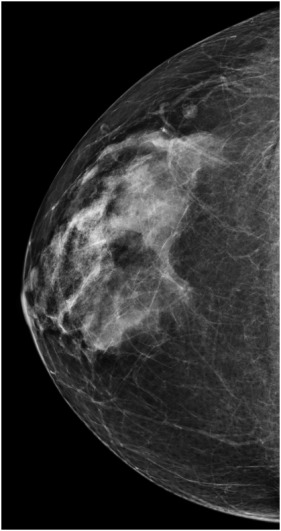
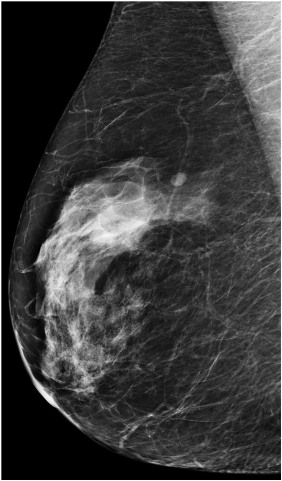
Figure 1: Craniocaudal and MLO views of the right breast on demonstrate stable appearance of an intramammary lymph node in the upper outer quadrant.
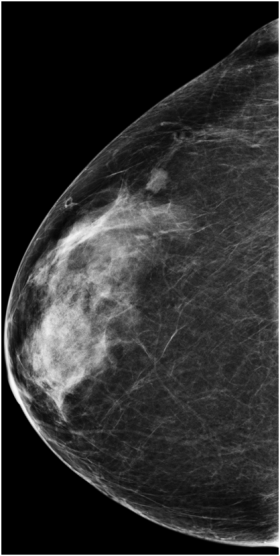
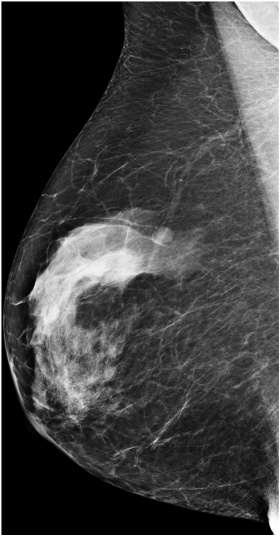
Figure 2: Craniocaudal and MLO views of the right breast at subsequent one-year follow-up demonstrate increased size of the intramammary lymph node with irregular borders.
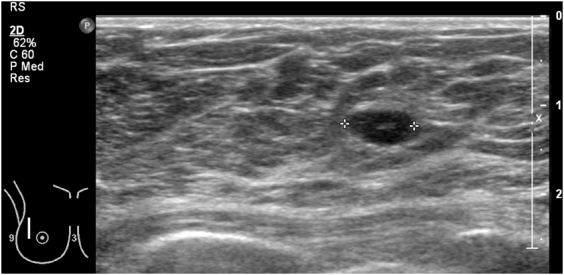
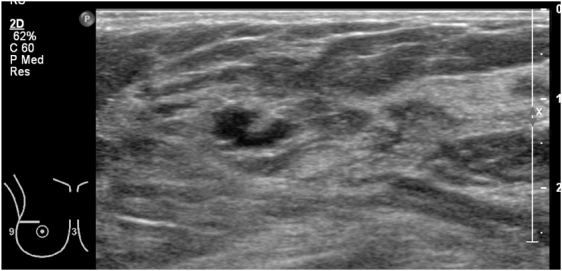
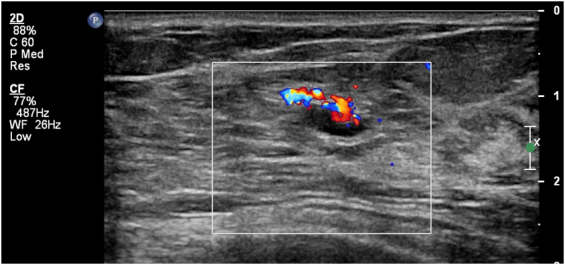
Figure 3: Ultrasound evaluation demonstrated that the lymph node was slightly irregular with increased cortical thickness and was hypervascular. The node was biopsied.
Diagnosis:
Pathology demonstrated lymphoid tissue proliferation around irregular germinal centers. Immunohistochemistry was performed demonstrating lymphoid follicles in which the germinal center cells were diffusely positive for CD10, BCL-2, and BCL-6 whereas the interfollicular regions were positive for CD20 and negative for CD5, CD43 or cyclin-D1. CD3 highlights the T-cell areas. MIB-1 proliferative index was high in the germinal centers. The results supported the diagnosis of follicular lymphoma.
Conclusion:
Mammography is used as a screening test for early detection of breast cancer, however occasionally other malignancies or disease processes can be detected and diagnosed as a result of screening mammography. Primary or secondary lymphoma in the breast is a rare entity.1,2 The estimated incidence of primary breast lymphoma ranges from 0.4 percent to 0.5 percent of all breast malignancies while the incidence of secondary lymphoma is approximately 0.07 percent of all breast malignancies.1,2,3,4
Thomas Cade Raggio, MD, and Erini Makariou, MD, Georgetown Hospital, Washington DC
References:
1. Duncan VE, Reddy VV, Jhala NC, Chhieng DC, Jhala DN. Non-Hodgkin's lymphoma of the breast: a review of 18 primary and secondary cases. Ann Diagn Pathol. 2006;10:144–148. doi: 10.1016/j.anndiagpath.2005.09.018.
2. Domchek SM, Hecht JL, Fleming MD, Pinkus GS, Canellos GP. Lymphomas of the breast: primary and secondary involvement. Cancer. 2002;94:6–13. doi: 10.1002/cncr.10163
3. Vignot S, Ledoussal V, Nodiot P, Bourguignat A, Janvier M, Mounier N, Cherel P, Floiras JL, Turpin F. Non-Hodgkin's lymphoma of the breast: a report of 19 cases and a review of the literature. Clin Lymphoma. 2005;6:37–42.
4. Anuradha Sinha A, Ramrakhiani D. Primary non-Hodgkin's lymphoma of the breast: a case report. Acta Cytol. 2005;49:661–665.
What New Research Reveals About Novice Use of AI-Guided Cardiac Ultrasound
April 4th 2025In a study recently presented at the American College of Cardiology (ACC) conference, researchers found that novice use of AI-guided cardiac ultrasound after an AI-enabled electrocardiogram increased the positive predictive value for reduced left ventricular ejection fraction (LVEF) or aortic valve stenosis by 33 percent.
The Reading Room Podcast: Current Perspectives on the Updated Appropriate Use Criteria for Brain PET
March 18th 2025In a new podcast, Satoshi Minoshima, M.D., Ph.D., and James Williams, Ph.D., share their insights on the recently updated appropriate use criteria for amyloid PET and tau PET in patients with mild cognitive impairment.
Study with CT Data Suggests Women with PE Have More Than Triple the One-Year Mortality Rate than Men
April 3rd 2025After a multivariable assessment including age and comorbidities, women with pulmonary embolism (PE) had a 48 percent higher risk of one-year mortality than men with PE, according to a new study involving over 33,000 patients.
GE HealthCare Debuts AI-Powered Cardiac CT Device at ACC Conference
April 1st 2025Featuring enhanced low-dose image quality with motion-free images, the Revolution Vibe CT system reportedly facilitates improved diagnostic clarity for patients with conditions ranging from in-stent restenosis to atrial fibrillation.